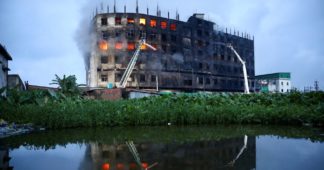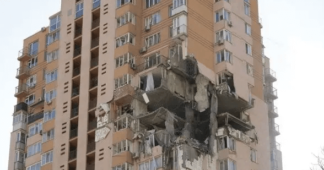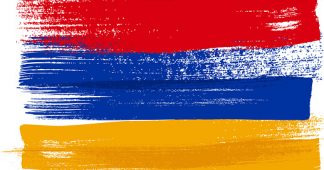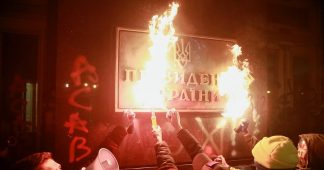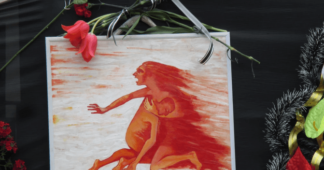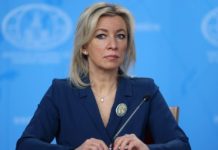Odessa has imposed a two-day curfew on the anniversary of the burning alive of anti-Maidan protestors on May 2, 2014, reports Joe Lauria.
By Joe Lauria
Apr 30, 2022
Authorities in the Ukrainian port city of Odessa have set a 24-hour curfew from May 1-3 to prevent protests commemorating the burning alive on May 2, 2014 of 48 people who had rejected the U.S.-backed coup in Kiev earlier that year.
The city, which is “(under the control of Ukrainian troops) announced the introduction of a ‘curfew’ in the city from 22-00 on May 1 to 5-00 on May 3. For the duration of the ‘curfew’ Odessans are not allowed to leave their homes,” said the group Repression of the Left and Dissenters in Ukraine in a Telegram post. “Obviously, this decision of the authorities is due to the fact that May 2 is a very important date for the inhabitants of Odessa.”
On that day eight years ago hooligans and far-right groups deliberately set fire to a labor union building where protestors against the coup had taken refuge. Police did not intervene. Video footage shows at least one police officer and others firing their guns into the building. The crowd is cheering as many of the people trapped inside jumped to their deaths.
The events of that day “have not yet been investigated by law enforcement agencies of Ukraine,” the group said. Pleas at the time from the United Nations and the European Union for Ukraine to investigate were ignored. Three Ukrainian local government probes were stymied by the withholding of secret documents.
A report on the incident from the European Council (EC) at the time makes clear it did not conduct its own investigation but relied on local probes, especially by the Verkhovna Rada’s Temporary Investigation Commission. The EC complains in its reports that it too was barred from viewing classified information. Relying on the local inquiries, the EC reports that pro-Russian, or pro-federalist, protestors attacked a pro-unity march in the afternoon, prompting street battles. Then:
“At around 6.50 p.m. pro-federalists broke down the door [of the trade union building] and brought inside various materials, including boxes containing Molotov cocktails and the products needed to make them. Using wooden pallets which had supported tents in the square, they blocked the entrances to the building from the inside and erected barricades. When they arrived at the square at around 7.20 p.m., the pro-unity protesters destroyed and set fire to the tents of the Anti-Maidan camp. The remaining pro-federalism protesters entered the Trade Union Building, from where they exchanged shots and Molotov cocktails with their opponents outside. …
At about 7.45 p.m. a fire broke out in the Trade Union Building. Forensic examinations subsequently indicated that the fire had started in five places, namely the lobby, on the staircases to the left and right of the building between the ground and first floors, in a room on the first floor and on the landing between the second and third floors. Other than the fire in the lobby, the fires could only have been started by the acts of those inside the building. The forensic reports did not find any evidence to suggest that the fire had been preplanned. The closed doors and the chimney effect caused by the stairwell resulted in the fire’s rapid spread to the upper floors and a fast and extreme rise in the temperature inside the building.”
The local investigation thus blamed the anti-Maidan protestors for starting the fire throughout the building. But this video, which shows events on that day leading to the fire, depicts the main blaze in the lobby. It shows Right Sector extremists lobbing Molotov cocktails into the building and a policeman firing his gun at it. It does not show any cocktails thrown from the building. It doesn’t show clashes earlier in the day, though one pro-unity protestor says they were attacked at Cathedral Square and they’ve come to burn the anti-Maidan protestors in the building for revenge:
The New York Times buried the first news of the massacre in a May 2, 2014 story, saying “dozens of people died in a fire related to clashes that broke out between protesters holding a march for Ukrainian unity and pro-Russian activists.”
The Times then published a video report that said dozens were killed in a fire, “and others were shot dead when fighting between pro- and anti-Russian groups broke out on the streets of Odessa.” The video narrator says “crowds did their best to save lives.” It quotes Ukrainian police saying a “pro-Kiev march was ambushed … petrol bombs were thrown” and gun battles erupted on the streets.
The late Robert Parry, who founded Consortium News, reported on Aug. 10, 2014:
“The brutality of these neo-Nazis surfaced again on May 2 when right-wing toughs in Odessa attacked an encampment of ethnic Russian protesters driving them into a trade union building which was then set on fire with Molotov cocktails. As the building was engulfed in flames, some people who tried to flee were chased and beaten, while those trapped inside heard the Ukrainian nationalists liken them to black-and-red-striped potato beetles called Colorados, because those colors are used in pro-Russian ribbons.
‘Burn, Colorado, burn’ went the chant.
As the fire worsened, those dying inside were serenaded with the taunting singing of the Ukrainian national anthem. The building also was spray-painted with Swastika-like symbols and graffiti reading ‘Galician SS,’ a reference to the Ukrainian nationalist army that fought alongside the German Nazi SS in World War II, killing Russians on the eastern front.”
“Every year on May 2, residents of Odessa come to the House of Trade Unions, where the tragedy occurred, to honor the memory of the victims,” the Ukrainian leftist group said. “But also every year on this day they are attacked by representatives of ultra-right groups with the inaction of the police.”
“This year,” the group said, “the authorities decided to prevent any gathering on May 2nd. Everyone who leaves their home on May 2 will be detained under the terms of the ‘curfew.’”
Sparked Donbass Rebellion
“This event became the trigger for the uprising in the Donbass,” Repression of the Left and Dissenters in Ukraine said. Eight days after the Odessa massacre, coup resisters in the far eastern provinces of Donetsk and Lugansk, bordering on Russia, voted in a referendum to become independent from Ukraine.
The U.S.-backed coup government then launched a military attack against the breakaway provinces, which continued for nearly eight years, killing thousands of people before prompting Russian intervention in the civil conflict. Russia says it has proof that the Ukrainian military, which had amassed 60,000 of its troops at the line of contact, were on the verge of an offensive to retake the provinces. OSCE maps showed a dramatic increase of shelling from the government side into the rebel areas in the last week of February.
On Feb. 24 Russia invaded Ukraine with the stated purpose of “de-Nazifying” and “de-militarizing” Ukraine to protect Russian-speakers and the people of Donbass. In a televised address three days before the invasion, Russian President Vladimir Putin mentioned the events of May 2, 2014 in Odessa.
“One shudders at the memories of the terrible tragedy in Odessa, where peaceful protesters were brutally murdered, burned alive in the House of Trade Unions,” he said. “The criminals who committed that atrocity have never been punished, and no one is even looking for them. But we know their names and we will do everything to punish them, find them and bring them to justice.”
The demonstrators in Odessa that day were protesting the violent overthrow on Feb. 21, 2014 of the democratically-elected President Viktor Yanukovych. U.S. involvement in the coup is revealed in a leaked telephone conversation between Undersecretary of State Victoria Nuland and Geoffrey Pyatt, the U.S. ambassador to Ukraine at the time.
* Joe Lauria is editor-in-chief of Consortium News and a former U.N. correspondent for The Wall Street Journal, Boston Globe, and numerous other newspapers. He was an investigative reporter for the Sunday Times of London and began his professional work as a 19-year old stringer for The New York Times. He can be reached at joelauria@consortiumnews.com and followed on Twitter @unjoe
Published at consortiumnews.com
We remind our readers that publication of articles on our site does not mean that we agree with what is written. Our policy is to publish anything which we consider of interest, so as to assist our readers in forming their opinions. Sometimes we even publish articles with which we totally disagree, since we believe it is important for our readers to be informed on as wide a spectrum of views as possible.
